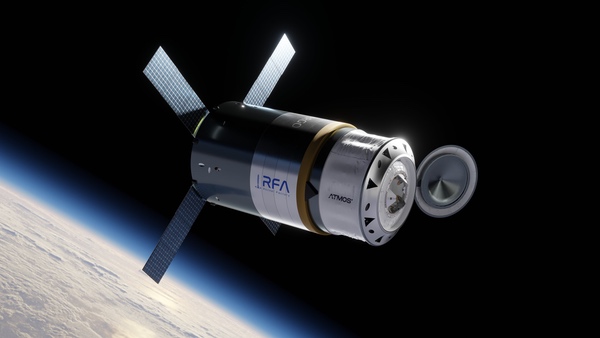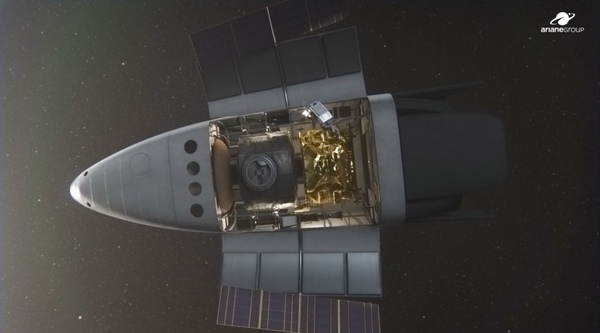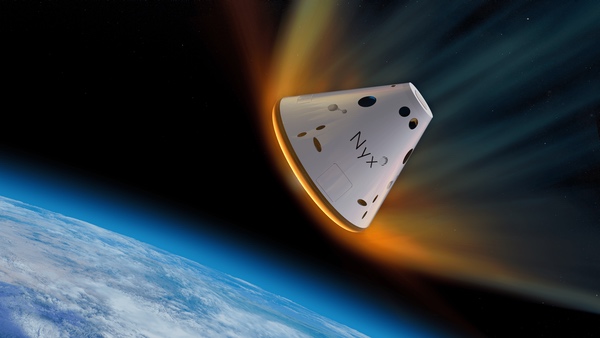Europe’s tentative step towards human spaceflightby Jeff Foust
|
| “I’m asking for a small but very impactful step, the first step that enables a much bigger ambition,” said Aschbacher. |
After the meeting, ESA announced that member states had approved a step in the direction of human spaceflight. They agreed to direct ESA to begin work on a commercial cargo program, supporting work on vehicles that could transport cargo to and from the International Space Station and, potentially, commercial space stations starting as soon as 2028.
“I’m asking for a small but very impactful step, the first step that enables a much bigger ambition,” ESA director general Josef Aschbacher said in remarks opening the summit.
That “bigger ambition,” he made clear, was a crew vehicle. “The service vehicle could later evolve into a crew vehicle and serve other destinations,” he said, “if member states so decide.” The cargo vehicle, he argued, would develop technologies in transportation, docking, and return that don’t exist today and could support a later crewed vehicle.
ESA provided few details at the summit about how the competition would actually work. Aschbacher said the agency would immediately create a small “tiger team” tasked with developing the competition. “We would like to go fast,” he said. ESA has earmarked 75 million euros ($81 million) from existing exploration programs that would go to two or three companies for initial design studies.
He didn’t give a date for when ESA would award that funding, but suggested it would be done in advance of CM25, the next major ministerial meeting of ESA member states in late 2025, when members set priorities and allocate funding for programs for the next three years.
 Rocket Factory Augsburg, working with ATMOS Space Cargo and other companies, unveiled a cargo vehicle concept called Atmos in September. (credit: RFA) |
“In the next two years, we will work with a number of proposals from private operators for delivering cargo to LEO,” said Géraldine Naja, ESA’s director of commercialization, in a talk November 14 at the Space Tech Expo Europe conference in Bremen, Germany. “There will be the decision by the member states at the next ministerial council on whether we continue with this approach and whether we continue with cargo in LEO or crew in LEO or cargo for the Moon.”
That schedule, from a standing start to a spacecraft docking with the ISS in five years, is ambitious. The ESA program is patterned on NASA’s Commercial Orbital Transportation Services (COTS) program to develop commercial cargo vehicles for the ISS. SpaceX, which won one of the COTS awards in 2006, a year after NASA announced plans for the program, flew its cargo Dragon to the ISS for the first time in 2012.
Aschbacher acknowledged that aggressive schedule. “It is quite fast,” he said of that schedule. “It is also very bold.”
| “Seville made a wise decision to start with a cargo version,” said ArianeGroup’s Godart. “This is why, at ArianeGroup, we started development on SUSIE.” |
And Europe is not necessarily starting from a standstill on commercial cargo. Several companies, both entrepreneurial and established, have put forward proposals for vehicles that could serve ESA’s needs for cargo delivery and, in some cases, be the basis for future crewed vehicles.
One is The Exploration Company, a startup that, in February, raised 40.5 million euros in a Series A round, the largest such round by a European space startup. The company is working on a vehicle called Nyx designed to carry cargo to and from low Earth orbit, with the potential for later evolving it to a crewed vehicle. The company plans to launch its first subscale demonstrator spacecraft next year.
“Opening a competition and awarding service contracts to companies is a historic milestone for Europe,” the company posted on social media after the ESA announcement, drawing parallels to the NASA COTS program. “We wish the same impact for the European industry!”
Rocket Factory Augsburg (RFA), a German company developing on a small launch vehicle, revealed in September that it is working on its own cargo vehicle concept called Argo in cooperation with another startup, ATMOS Space Cargo, along with larger aerospace companies OHB and Sener. The spacecraft would deliver cargo to the ISS and return cargo to Earth using a capsule with an inflatable decelerator.
Stefan Tweraser, CEO of RFA, said during a panel at Space Tech Expo Europe that the concept was enabled by the partnership among the companies, none of which had internally all the capabilities needed for a cargo vehicle. “The strength of the European space industry is that there are many specialized players out there who are primed for cooperation,” he said. “That can be the foundation of an entirely new business.”
At the other end of the corporate spectrum is ArianeGroup, the prime contractor for the Ariane 6. Last year, the company unveiled a concept called the Smart Upper Stage for Innovative Exploration (SUSIE) intended to be a reusable upper stage that could also be configured as a cargo or crew vehicle.
At Space Tech Expo Europe, ArianeGroup showed off models of SUSIE, including one configured as a crew vehicle. “Seville made a wise decision to start with a cargo version,” said Pierre Godart, CEO of ArianeGroup Germany, in a conference panel. “This is why, at ArianeGroup, we started development on SUSIE.”
Some European government officials at the conference endorsed the commercial cargo competition as a step towards a crewed vehicle. “We were more in the passenger seat, never in the driver’s seat” in human spaceflight, remarked Philippe Baptiste, CEO of the French space agency CNES, at the conference. That was in large part because of the cost, he argued, a decision that needs to be revisited as space access costs drop.
 ArianeGroup’s SUSIE is a reusable upper stage that could also be used as a cargo or crew vehicle. (credit: ArianeGroup) |
A European commercial crew capability, he said, would be useful in a future era of private space stations that largely involve American companies. He would like to see European astronauts on those stations, but noted that won’t be for free. “I would rather have this amount of money being spent in Europe than in any other part of the world.”
| “If we go to the direction that we have our own astronauts that go on our own capsules and everything, it’s a matter of budget, it’s a matter of political will,” said Steckling. |
He added that he went as far to propose at the Space Summit that ESA help develop its own commercial space stations, following the model of NASA’s Commercial LEO Destinations program. “Why are we not able in Europe to have a similar mechanism to have European private companies develop a private space station?” he said. “I hoped we could get some kind of answer in Seville to this question, but the room remained silent.”
Others appeared to want ESA to be more aggressive, based on questions at both the press conference after the Space Summit and during Space Tech Expo Europe that argued that Europe was aiming too low by focusing on a cargo vehicle rather than going directly to a crew vehicle.
The answers from some to those questions pointed to issues of funding and priorities. “Big ambitions are good,” said Walther Pelzer, director-general of the German Space Agency at DLR, when asked about that at Space Tech Expo Europe. “But, what we need to make sure is to put it into practice. If we try to do everything in Europe right now, we would end up with mediocre results, and that would be worse than the current situation.”
“If we go to the direction that we have our own astronauts that go on our own capsules and everything, it’s a matter of budget, it’s a matter of political will,” said Marc Steckling, head of Earth observation, science, and exploration at Airbus Defence and Space, during another conference panel.
“Does Europe need to reproduce everything that is existing elsewhere already?” he asked, suggesting Europe continue its approach of partnering with the United States and other nations. “I would favor having the right competencies, the right skills in order to be attractive for collaborations.”
Those questions about funding levels and priorities will linger at least through the next major ministerial meeting in two years. “Today’s Space Summit is not a funding summit,” Aschbacher said at the briefing after the summit, thus limiting what ESA could achieve at it in terms of human spaceflight. “I’m asking for a first step in order to build up a program proposal, which, of course, we will now prepare with our member states for funding at CM25.”
During the opening session of that Space Summit, ESA officials and representatives of its member states had a special guest: ESA astronaut Andreas Mogensen, who participated via a live video link from the ISS. He offered a bit of a history lesson, and a warning, to the delegates.
“I’m reminded of the fact that, 25 years ago, ESA and Europe were debating the construction of the Hermes crewed space vehicle,” he said. (Hermes, in fact, had already been cancelled by ESA some 30 years ago.) “I can’t help but think what position Europe would be in today if we had developed Hermes. We would have been able to launch astronauts to the International Space Station and to take over in 2011 after the shuttle retirement.”
“I’m wondering, 25 years from now,” he continued, “will we look back on today and say, ‘if only we had made the investments,’ or do we have the vision today and the courage today to make the necessary investments that will enable European participation in space in the future?”
Note: we are using a new commenting system, which may require you to create a new account.
